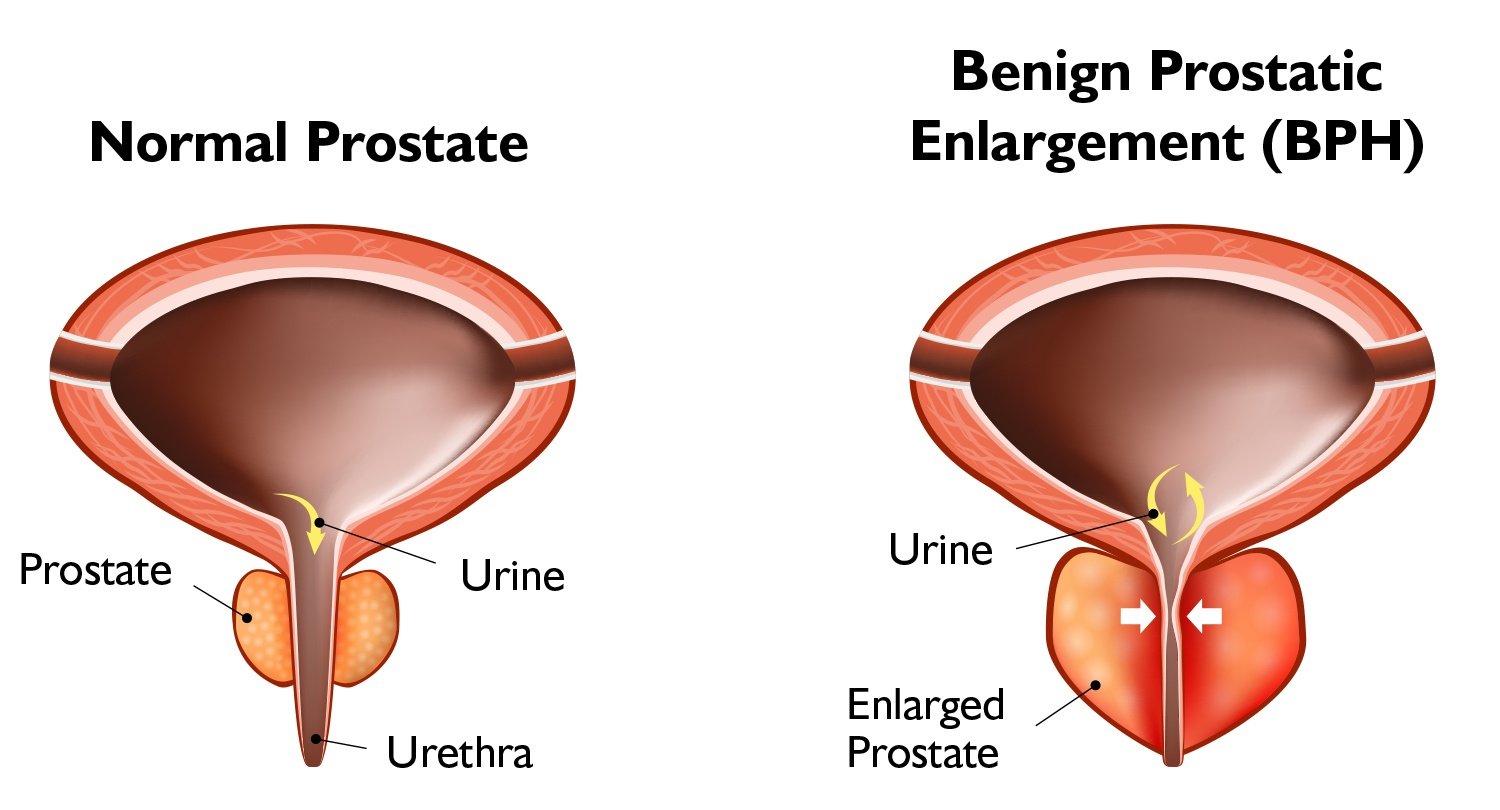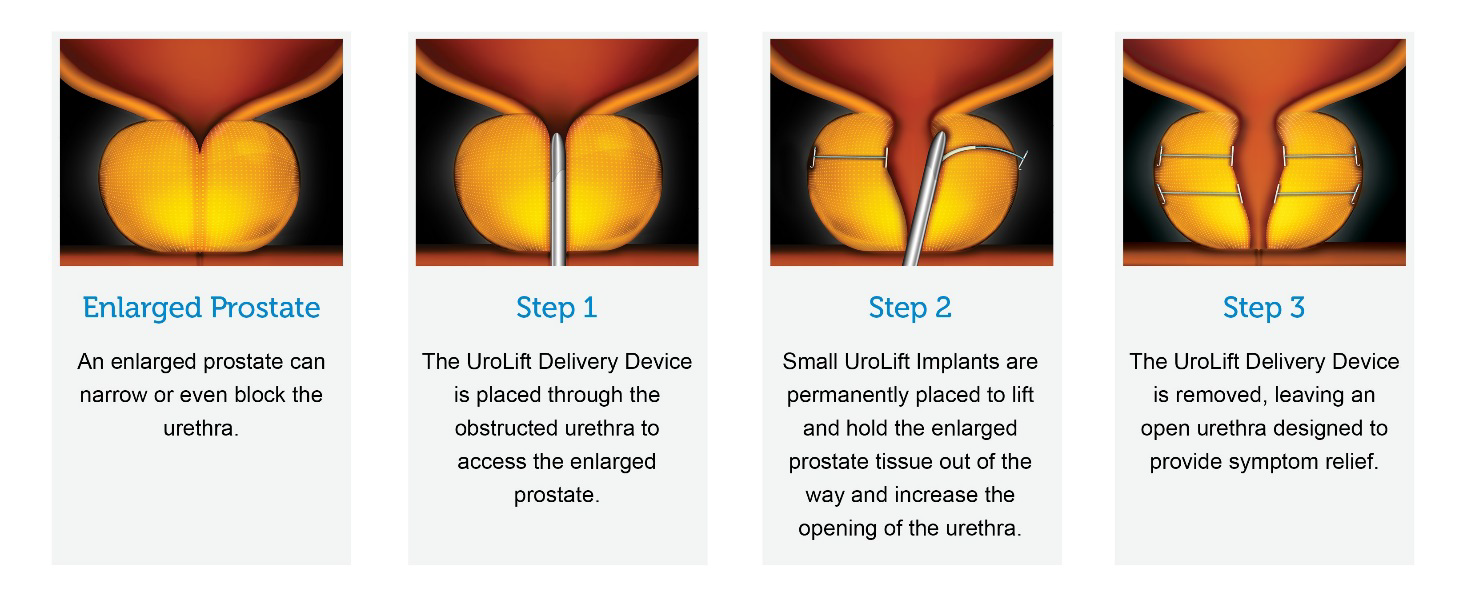Quick Facts
Urolift
- One-time in office procedure
- Provides rapid relief for enlarged prostate
- Frees men from ongoing BPH medications

Urolift
Our Urolift Specialists
What is BPH?
Benign Prostatic Hyperplasia, or BPH, is a condition in which the prostate enlarges as men get older. BPH is a very common condition that affects nearly 40 million Americans and over 500 million aging men worldwide. Over 40% of men in their 50s and over 70% of men in their 60s have BPH1. While BPH is a benign condition and unrelated to prostate cancer, it can greatly affect a man’s quality of life.
As the prostate enlarges, it presses on and blocks the urethra, causing bothersome urinary symptoms such as:
- Frequent need to urinate both day and night
- Weak or slow urinary stream
- A sense that you cannot completely empty your bladder
- Difficulty or delay in starting urination
- Urgent feeling of needing to urinate
- A urinary stream that stops and starts
If you suffer from the above symptoms, you are not alone. BPH is the leading reason men visit a urologist2.

1. Berry, et al., Journal of Urology 1984
2. IMS Health NDTI Urology Specialty Profile Report 2013
What is the UroLift System?
Treatment with the UroLift® System uses a minimally invasive approach that provides rapid relief and recovery of BPH symptoms.1 It is an earlier treatment option can get men off BPH medications and avoid major surgery. The goal of the UroLift System treatment is to relieve symptoms so you can get back to your life and resume your daily activities.
The UroLift® System treatment has demonstrated a significant improvement in quality of life for patients compared to medications.2,3 The UroLift® System is the only BPH procedure shown not to cause new and lasting erectile or ejaculatory dysfunction*, while being a safe and effective treatment of lower urinary tract symptoms due to BPH.
How Does The UroLift® System Work?
The UroLift® System uses a revolutionary approach to treating BPH that lifts and holds the enlarged prostate tissue so it no longer blocks the urethra. It is the only available BPH treatment performed by a urologist that does not require heating, cutting, or removal of the prostate tissue. The procedure is typically performed using local anesthesia in a physician’s office or ambulatory surgery center. Patients typically return home the same day without a catheter.

Talking to Your Doctor about BPH
BPH is a very common condition and is one of the leading reasons men visit a urologist. Whether you have just started experiencing symptoms or if you’ve tried various medications or even surgery, there are a range of treatment options available.
Before you visit the doctor’s office, you can take this BPH Symptom Quiz, designed by the American Urological Association, to determine the severity of your symptoms. We will discuss your symptoms together to decide which
treatment option is best for you.
Schedule an appointment today to discuss your BPH symptoms with us.
Please contact us at (888)-876-5649

Frequently Asked Questions
You may be a good candidate if you are a male, 45 years of age or older, and have symptoms relating to BPH. Speak with your urologist to see if the UroLift® System treatment is right for you. If you have a known allergy to nickel, titanium or stainless steel, talk to your doctor about your allergy before getting a UroLift System treatment.
If you and your doctor decide that the UroLift® System treatment is right for you, your doctor will provide you with more detailed information relating to the treatment. In general, the UroLift System is a minimally invasive treatment that entails minimal downtime. Your doctor will use the UroLift Delivery Device to deploy permanent implants to relieve obstruction caused by the enlarged prostate that is pressing on your urethra. The procedure, which usually takes less than an hour, may be performed under local or general anesthesia and you may be given medication to feel comfortable during the treatment. This typically helps minimize discomfort during the procedure, though everyone’s definition for pain and discomfort varies greatly. Typically, no catheter and no overnight stay is required post-treatment.
After the treatment, patients typically go home the same day without a catheter. There is minimal downtime posttreatment and many patients experience symptom relief in as early as 2 weeks. Patients may experience some urinary discomfort during the recovery period. Most common side effects are mild to moderate and include pain or burning with urination, blood in the urine, pelvic pain, urgent need to urinate and/or the inability to control the urge. Most symptoms resolved within two to four weeks after the procedure.
Clinical studies have shown the UroLift® System treatment does not cause new, sustained instances of erectile or ejaculatory dysfunction. The same cannot always be said of other BPH therapies such as TURP, laser, and even medication.
The UroLift® System treatment is covered by Medicare and many private insurers. Contact your insurance provider for your specific coverage information.
The UroLift System consists of a delivery device and tiny permanent implants.
- The UroLift Delivery Device is placed through the obstructed urethra.
- Small UroLift Implants are placed to lift or hold the enlarged prostate tissue out of the way. The Implants are delivered through a small needle that comes out of the delivery device and into the prostate.
- The UroLift Delivery Device is removed, leaving an open urethra that provides symptom relief.
One unique aspect of the UroLift System is that it does not preclude retreatment or BPH treatments such as TURP or laser, should they be required in the future.
The Implants are intended to be permanent. The implant is made up of standard surgical implantable materials: a nitinol capsular tab, a stainless steel urethral tab, and polyethylene suture that holds the two tabs together. Your doctor can remove the urethral implant, if needed. The suture can be cut and the urethral endpiece can be retrieved with a standard grasper. The capsular tab will remain in place inside the body.
Request an appointment now
Getting an accurate diagnosis can be one of the most impactful experiences that you can have — especially if you’ve been in search of that answer for a while. We can help you get there.




